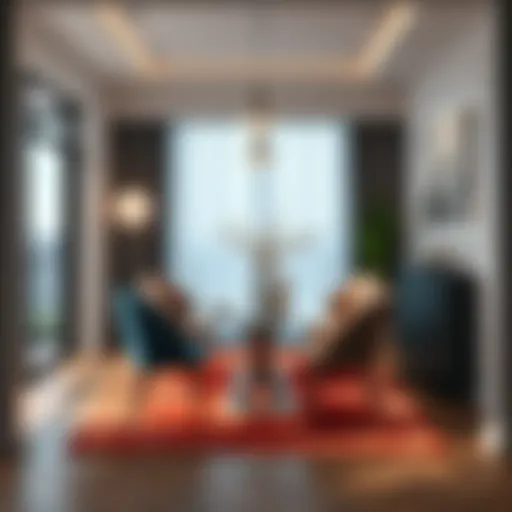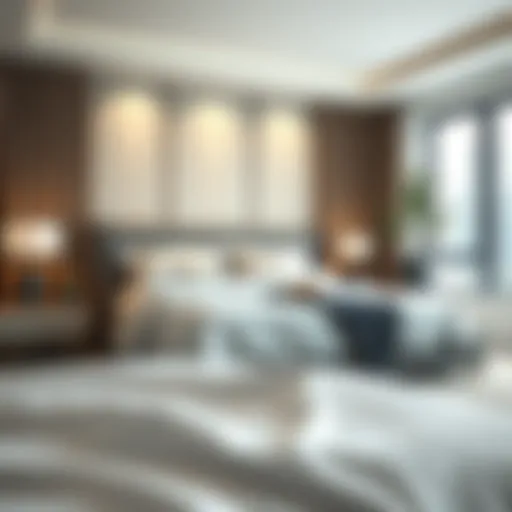Foam for Sound Proofing: Explore Types and Applications


Intro
In an era where noise pollution is an ever-growing concern, the quest for tranquility at home and in the workplace has led many to explore soundproofing solutions. Foam for soundproofing has emerged as a popular choice among homeowners, designers, and industry professionals alike. This comprehensive guide aims to peel back the layers of soundproofing foam, investigating its types, applications, and the science that makes it effective in mitigating unwanted noise.
Soundproofing foam isn’t just about silence; it’s about creating an environment that fosters concentration, relaxation, and auditory comfort. Whether it’s the bustling sounds of urban life seeping into your serene living space or the echo of footsteps in a bustling office, soundproofing foam offers a practical solution. With a focus on both residential and commercial applications, this article provides essential insights into maximizing acoustic quality.
We will journey through various types of foam, examining their effectiveness in different settings. You’ll discover installation methods that yield optimal results and explore real-world applications that highlight the foam’s versatility. For homeowners, this means answering questions about where to install foam for the best results. For designers, it opens a dialogue about balancing aesthetics and functionality. As for industry professionals, the integration of soundproofing foam is crucial to enhancing the spaces they create.
Furthermore, understanding the material properties and installation techniques is key. This exploration will empower you with the information needed to achieve peaceful sound control in any environment, whether it’s a cozy home theater, a professional recording studio, or even an open office space.
Let’s dive into the world of soundproofing foam and uncover its secrets.
Understanding Sound Proofing
Sound proofing isn't just a luxury; it's increasingly a necessity in our bustling world, where noise pollution can disrupt everything from personal peace to professional productivity. To grasp the full influence of sound proofing, it’s essential to recognize its fundamental role in defining our auditory environment. Understanding sound proofing involves simple concepts that lead to profound changes in how we experience sound in various settings. Whether one is in the cozy confines of a home theater or the hushed atmosphere of a reading nook, sound proofing serves as the guardian of tranquility.
What is Sound Proofing?
In basic terms, sound proofing refers to the techniques and materials used to reduce sound transmission between spaces. It's more than just throwing up some foam on the walls; it’s a calculated approach to managing sound. The process can involve several methods, including adding insulation, building barriers, and using specific sound-absorbing materials that cater to different frequencies of sound.
Sound proofing materials can block or absorb different kinds of sounds. For instance, heavy materials can block sound effectively, while foam products specifically designed for this purpose often serve to absorb sound waves. The end goal is to create a more serene environment, contributing significantly to comfort and quality of life.
Why Sound Proofing Matters
The importance of sound proofing stretches beyond mere convenience. Consider the everyday irritants, like the chatter of neighbors or the hum of traffic outside. These sounds can significantly impact concentration and relaxation.
- Health Benefits: Excessive noise can lead to stress and even long-term health issues, such as anxiety and sleep disorders. Sound proofing minimizes these external disturbances, leading to an overall improvement in well-being.
- Productivity Enhancement: In workspaces, noise distractions can fragment focus, leading to decreased efficiency. Implementing sound proofing solutions can create quieter, more conducive environments for creativity and productivity.
- Property Value: In a competitive real estate market, well-designed soundproof spaces often attract higher bids. Potential buyers are drawn to homes that promise quiet and tranquility, making sound proofing a wise investment.
The significance of understanding sound proofing lies in its ability to transform the quality of both personal and professional environments. By investing time and resources into proper sound mitigation methods, individuals can conquer the challenges of modern noise and cultivate spaces that foster comfort and productivity.
Types of Sound Proofing Foam
In the world of acoustic treatment, various types of soundproofing foam play crucial roles. They each have distinct characteristics and applications, catering to different needs in managing sound. Understanding these types is pivotal for anyone looking to enhance their audio environment, whether for home theaters, studios, or even office spaces. Let's explore some prominent types of soundproofing foam.
Acoustic Foam Panels
Acoustic foam panels are perhaps the most recognized type of soundproofing foam. These panels come in various shapes and sizes, with a common pyramid or wedge design that helps to diffuse sound waves. The primary role of these panels is to absorb sound rather than block it, making them essential for reducing echo and reverberation. A key advantage is their ability to enhance sound quality in recording and listening environments.
When hanging these panels on walls, the material's density and thickness play significant roles in their effectiveness. The thicker the panel, the more sound it can absorb. Generally, a thickness of two inches is recommended for typical use. Key considerations include:
- Placement: Positioning acoustic foam strategically in corners, on walls, and even ceilings can help tackle various sound issues.
- Aesthetics: Available in different colors and designs, these panels can complement the decor while serving their functional purpose.
Bass Traps
Bass traps are specialized forms of soundproofing foam designed to tackle low-frequency sounds, commonly found in music and film audio. These traps are usually thicker and denser than regular acoustic foam, as they need to absorb lower frequencies more effectively. Placing bass traps in corners is particularly beneficial since low-frequency sounds tend to accumulate in these areas due to wave cancellation.
Some details to remember about bass traps are:
- Positioning: Ideal placement includes corners where two walls meet and where the wall meets the ceiling.
- Control: By helping to control bass response, these traps prevent muddiness in audio, leading to a clearer overall sound.
Foam Egg Crate Panels
Foam egg crate panels, often found in various applications ranging from soundproofing to insulation, are characterized by their unique shape resembling an egg carton. This design allows for effective sound absorption due to the increased surface area. While they are not as specialized as bass traps or acoustic panels, they offer a decent level of sound dampening.
Key benefits include:
- Versatility: These panels can be used in a variety of settings, from studios to recreational spaces. They can be used in combination with other foam types for better results.
- Cost-effective: Generally, foam egg crate panels are more affordable compared to other specialized soundproofing solutions.
Sound Barrier Foam
Sound barrier foam is another important type of soundproofing material, which functions differently than acoustic foams. While acoustic foams absorb sound, sound barrier foams aim to prevent sound transmission altogether. This type of foam is often denser and thicker, designed to block sound waves from passing through.
Some considerations for sound barrier foam include:
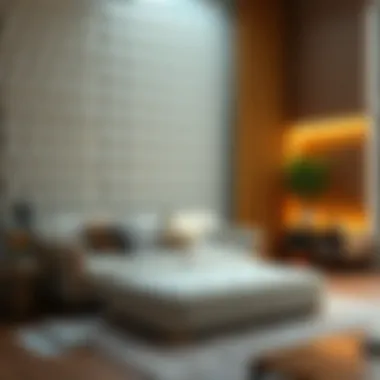

- Layering: It can be used alongside other sound absorption foams for a comprehensive soundproofing solution.
- Applications: Ideal for spaces that require confidentiality, such as recording studios and offices, where sound leakage is a concern.
Understanding the nuances between these different types of soundproofing foam allows homeowners, designers, and professionals to make informed decisions. With the right foam, one can greatly enhance the acoustic environment, making spaces more enjoyable and functional.
How Sound Proofing Foam Works
Understanding how sound proofing foam functions is crucial for anyone looking to enhance the acoustics of a room. It’s not merely about stuffing foam panels into corners; it’s about grasping the underlying principles that dictate sound behavior in enclosed spaces.
The Science of Sound Waves
Sound waves are more than just noise traveling through the air; they are vibrations that move through different mediums and can be influenced by various factors. When sound waves hit a solid object, such as a wall, they can either bounce off or be absorbed. This is where sound proofing foam comes into play. The foam’s porous structure traps sound waves, reducing their energy and preventing them from bouncing back into the room.
To put it plainly, think of sound waves like an energetic group of kids running down a hallway. If you have walls (or a lack of foam) they’ll bounce off each other, creating chaos. But add some foam – it’s like having a soft carpet to break their fall. This helps in minimizing noise and creating a more pleasant auditory environment.
Absorption vs. Blocking
There’s a common misconception that all soundproofing methods are created equal. Absorption and blocking serve different purposes in the world of sound mitigation.
- Absorption: This method focuses on soaking up sound waves to minimize echoes and reverberation. Acoustic foam panels are designed specifically for this purpose. They’re often used in recording studios and home theaters where clarity is vital.
- Blocking: This involves creating barriers that prevent sound from passing through. For example, insulated walls or solid doors can block sound from seeping in or out of a room.
A wise strategy often involves a combination of both absorption and blocking. By using sound proofing foam to absorb sound and adding solid barriers, you can create a well-rounded strategy for noise control.
Sound Absorption Coefficients
Sound absorption coefficients (SACs) are a numerical representation of a material's ability to absorb sound across different frequencies. The higher the coefficient, the better the material is at absorbing sound.
- Coefficients Range: Values range from 0.0 (no absorption) to 1.0 (total absorption).
- Material Variations: Different foam types come with different SACs. For instance, acoustic foam typically averages around 0.7 to 0.9 for mid-range frequencies, making it quite effective.
Understanding these coefficients helps in selecting the right sound proofing foam for your specific needs – whether it's a lively classroom or a tranquil office space.
In summary: Knowing how sound proofing foam works allows homeowners and professionals alike to create environments that are not just quieter, but also more suitable for their intended purposes. This knowledge enables better selection, placement, and combination of sound absorption and blocking techniques for maximum effectiveness.
Applications of Sound Proofing Foam
When it comes to enhancing acoustics, foam for sound proofing plays a pivotal role in various environments. Understanding the applications of this foam illuminates how it can improve auditory experiences, whether in a home theater, recording studio, or a corporate workspace. The benefits are pronounced and contribute not only to sound quality but also comfort and productivity.
Home Theater Environments
Creating an optimal home theater environment involves more than just the right projector or screen. Acoustic foam panels are essential for managing sound reflections and preventing echo, making movie nights more immersive. You might find that a room filled with bare walls can make sounds bounce awkwardly, ruining that Spielberg magic. Foam panels can be strategically placed on walls to absorb excess sound energy and offer clearer audio playback. Homeowners should pay attention to the placement of these panels; corners may require bass traps to address low-frequency build-up, while flat wall areas can utilize standard foam tiles.
Additionally, having sound proofing foam helps in maintaining the audio integrity of the space, which is crucial for movie enthusiasts and gamers alike. When the walls of your theater whisper back at you instead of amplifying noise, you know you've created a good sound environment.
Recording Studios
In a recording studio, sound accuracy is paramount. Here, sound proofing foam is not merely advisable; it's almost a necessity. Sound waves can distort during recording and mixing, leading to less than satisfactory results. Various forms of foam, including acoustic panels and bass traps, are deployed to ensure that the audio recording remains true to the original source.
Professionals often recommend installing foam on both the walls and ceiling to mitigate sound reflection and coupling, thus ensuring that recordings are clean and true. The placement of foam should be tailored to the size and layout of the studio; dense materials may lead to excellent results but could become counterproductive if not used carefully. For studios aiming to capture pristine sound, the subtleties offered by effective foam installation elevate the entire production process.
Corporate Office Spaces
Though often overlooked, corporate environments can greatly benefit from sound proofing foam. Open office designs, while trendy, can lead to distracting noise levels, affecting employee concentration and productivity. Implementing foam solutions like sound barrier panels can aid in diminishing unwanted noise disturbances caused by conversations or office equipment.
A room that feels friendly and inviting fosters collaboration without allowing distractions to creep in. For effective usage, consider acoustic clouds or paneling hung from ceilings. This creates a soothing atmosphere where employees can focus without disruptions, leading to higher output and a more harmonious work environment.
Educational Institutions
In educational spaces, sound proofing is critical for creating learning environments conducive to focus and engagement. From classrooms to auditoriums, foam solutions can minimize noise intrusion, making it easier for students to absorb lessons without the chaos of external sound disrupting their learning.
Schools with music programs particularly benefit from employing sound proofing foam; it allows for rehearsal rooms that can both absorb sound and reduce bleed into adjacent spaces. Adding foam not only enhances the auditory experience but also ensures compliance with regulations regarding sound levels, which can be particularly important in multi-use facilities.
Effective sound proofing in educational institutions has the potential to significantly impact students' learning outcomes and overall school performance.
Factors Influencing Effectiveness
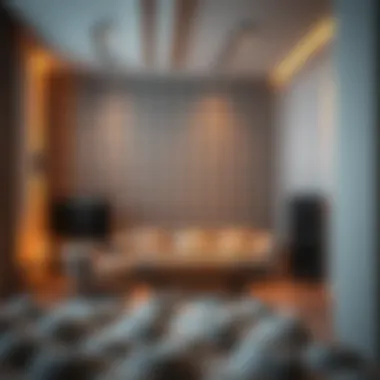

When it comes to soundproofing foam, understanding the factors that influence its effectiveness is crucial. Each element plays a vital role in shaping how well the foam performs in various environments. Homeowners, designers, and DIY enthusiasts should pay careful attention to these aspects to achieve optimal sound reduction.
Thickness of Foam
The thickness of soundproofing foam is perhaps one of the most significant factors determining its sound absorption capability. Thicker foam generally provides better performance when it comes to absorbing sound waves compared to thinner alternatives. This is because larger foam panels can trap and dissipate more sound energy before it bounces back into the room.
- A typical acoustic foam panel may range from one to four inches in thickness.
- For best results, consider using thicker foam in spaces where noise levels are particularly high, such as home theaters or recording studios.
- However, thicker foam might not always be ideal for smaller rooms, where space might become an issue. Finding the right balance is key.
Room Dimensions
The size and shape of a room significantly impact how sound travels and, thus, how effective your soundproofing foam can be. A large, empty room may have considerable echoes, causing sound to bounce around rather than being absorbed. On the other hand, smaller or oddly shaped rooms may struggle with sound waves becoming trapped, leading to issues like distortion or uneven sound.
- Ceiling Height: High ceilings can affect how sound dissipates, while lower ceilings may enhance sound absorption.
- Room Shape: Non-standard shapes can complicate sound wave paths, hence the placement of foam needs careful consideration.
- Ultimately, the dimensions can inform how foam placement optimizes performance, taking into account reverb time and overall sound quality.
Surface Materials
The materials surrounding the soundproofing foam can augment or hinder its effectiveness. Hard surfaces like wood, glass, or tile tend to reflect sound waves, reducing the foam's ability to absorb noise. In contrast, softer surfaces—such as carpeting and curtains—can complement foam installation by dampening sound further.
- Hard Surfaces: If your room has such surfaces, using denser foam options or wider panels can help counter reflections.
- Soft Furnishings: The combination of foam with textiles also enhances overall acoustics. Incorporating rugs or upholstered furniture can create a balanced environment.
- An understanding of how these factors work together can result in a comprehensive approach to soundproofing.
"The journey to ideal soundproofing is a mix of science and art, where each factor wields its influence on the acoustics of a space."
In summary, being mindful of the thickness of foam, room dimensions, and surrounding materials can substantially affect soundproofing efforts. These elements are not stand-alone; they interact, creating a fabric of acoustic performance within your chosen space. By addressing these factors thoughtfully, you pave the way to a quieter, more serene environment.
Installation Methods
Installation methods play a crucial role in how effective soundproofing foam can be in various environments. The process of installing foam correctly can dramatically influence its sound-absorption capabilities. Understanding the nuances of the installation can lead not only to better acoustic performance but also to long-term benefits such as space aesthetics and maintenance ease.
Choosing the right installation technique often depends on factors like the type of foam used, the intended application, and the characteristics of the space. It’s not just about sticking the foam on the wall; it involves considering dimensions, angles, and surface types among other elements. The successful application of soundproofing materials results in a decrease in noise pollution, creating a calmer and more productive environment.
"The way you install soundproofing foam can make all the difference in how effective it is in its job."
DIY Installation Techniques
DIY installation techniques offer homeowners and enthusiasts a chance to take soundproofing into their own hands. The appeal lies in cost savings and personal investment in the space. Here’s a look at some key methods to approach DIY installation:
- Preparation: First, assess the area where the foam will be installed. Measuring the dimensions accurately can save you a great deal of trouble later.
- Material Selection: Depending on your needs, choose the type of foam. Acoustic panels generally require less precision than bass traps or barrier foams.
- Adhesive Options: Many people prefer using adhesive spray or double-sided tape for easy application. Ensure that the surfaces are clean, dry, and free from any coatings.
- Placement Strategy: For maximum effectiveness, place the foam at first reflection points or behind speakers. This placement can help manage sound waves better and absorb undesirable echoes.
- Tools You May Need: Besides your foam sheets, have scissors or a utility knife ready for trimming, and perhaps a level to ensure straight lines.
While a DIY approach exudes the charm of personal touch, it's vital to acknowledge that time management and accuracy are equally important.
Professional Installation Recommendations
For those who prefer a hassle-free path or rather focus their energy on other aspects of their project, professional installation is often the way to go. Here are some insightful considerations about professional installation:
- Expertise: Professionals come armed with experience. They understand the complexities of soundproofing materials and how to make them perform at their best.
- Customization: A professional can also better tailor the solution based on the unique characteristics of your room. This ensures a more refined approach than standard DIY methods.
- Tools and Techniques: Installation professionals often use specialized tools like acoustic measuring instruments, which provide precise insights into how and where to place the foam for optimal performance.
- Time-Efficiency: Hiring experts can significantly cut down the time needed for installation. Given their expertise, they’ll likely be able to complete the task in a fraction of the time it would take an untrained individual.
- Long-term Assurance: Many professionals provide guarantees for their work. This assurance can offer peace of mind that your investment is protected and that the project will deliver intended results.
Whether opting for a DIY installation or hiring professionals, it’s clear that the method chosen will play a pivotal role in how effectively soundproofing foam can improve acoustic quality in diverse environments. Each option carries its own set of benefits which should align with individual needs and project goals.
For more detailed insights, consider referring to resources like Acoustical Society of America or Wikipedia's page on Soundproofing for further reading.
Cost Considerations
When it comes to any home improvement or renovation project, understanding cost considerations is essential. Soundproofing foam, while highly effective for enhancing acoustics, does carry expenses that can significantly influence a project's overall budget. This section dives into the nitty-gritty of what homeowners, designers, and DIY enthusiasts should keep in mind when diving into sound proofing foam.
Budgeting for Sound Proofing Foam
Establishing a budget for sound proofing foam is a critical first step. This involves more than just knowing how much the foam itself costs. Here are a few factors to consider when budgeting:
- Material Quality: Prices for soundproofing foam can vary widely based on material quality. High-density acoustic panels may cost more upfront but could provide significantly better sound absorption.
- Quantity Needed: Measure your space carefully. It’s essential to account for the size of the area you want to soundproof to determine how much foam is required. Overspending on excess foam, or underestimating needs, can throw your budget off-course.
- Installation Costs: Think about whether you’ll go with a DIY approach or hire professionals. DIY can save money, but professional installation may ensure more effective soundproofing, leading to better long-term results.
It's wise to make a detailed list of all potential costs. Don’t forget to factor in additional expenses like adhesives, tools, and possibly permits if you’re making extensive alterations to your space.
Long-term Value vs. Initial Investment
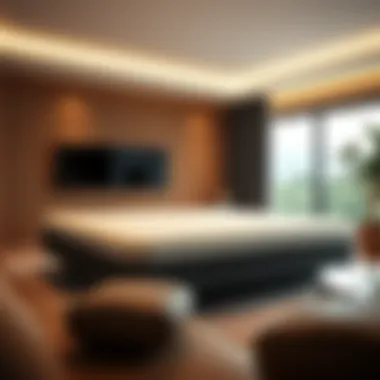

Soundproofing foam isn't just a one-shot deal. While the initial investment might seem stiff, it’s crucial to view this expense through the lens of long-term value. Here’s why thinking ahead makes sense:
- Increased Property Value: Homes with effective soundproofing can attract buyers who prioritize quiet living spaces. This added value can outweigh the initial spending.
- Quality of Life: Consider the daily impact of noise pollution on your comfort at home or work. Investing in soundproofing can mitigate disturbances, leading to better rest and reduced stress.
- Durability: Quality soundproofing foam can last years, meaning your investment pays off over time. Beware of cheap options that may degrade quickly, inevitably costing more in the long run due to replacements or repairs.
"A stitch in time saves nine" - investing smartly today on soundproofing can save you headaches and expenses down the line.
Sustainable Sound Proofing Solutions
As society becomes increasingly aware of the environmental footprint of construction and renovation projects, the demand for sustainable sound proofing solutions has risen significantly. Homeowners, designers, and industry professionals alike are on the lookout for ways to combine effectiveness in sound management with eco-friendliness. Choosing materials that minimize ecological impact not only enhances acoustic performance but also aligns with a growing preference for sustainability in home improvement practices.
The magic of sustainable sound proofing lies in its ability to offer effective sound mitigation alongside various environmental benefits. Eco-friendly foam options, recycled materials, and innovative disposal methods promote a healthier planet while aiming to create serene living and working spaces. These solutions help to maintain a balance between comfort and ecological responsibility, two considerations that are gaining traction in modern construction.
Eco-Friendly Foam Options
When it comes to eco-friendly foam, several choices come to the forefront. One popular option is natural latex foam, derived from rubber trees. This type of foam is biodegradable and exhibits excellent sound absorption properties. Moreover, it’s free from harmful chemicals often found in synthetic foams, making it a healthier choice for both users and the environment.
Another noteworthy alternative is recycled polyurethane foam. Made from post-consumer waste, this foam not only helps in reusing materials but also performs admirably as a sound barrier. It is crucial, however, to ensure that the production processes involved in creating recycled foam do not offset the environmental benefits. Manufacturers should follow green practices throughout the lifecycle of the product, ensuring sustainability is at the heart of their operations.
Not to be overlooked, sheep wool insulation has become a favored choice in sustainable soundproofing. Its natural properties not only provide thermal insulation but also serve to absorb sound effectively. Wool is fully biodegradable and can often be sourced locally, reducing transportation emissions.
Recycling and Disposal
Disposing of soundproofing foam responsibly is just as important as the materials used. Many types of foam, particularly those made from synthetic materials like standard polyurethanes, are not easily recyclable and can end up in landfills where they take centuries to decompose. Thus, understanding the disposal options available is essential for promoting a sustainable approach.
Proper disposal of soundproofing materials is critical not only for environmental preservation, but also for personal safety. Always consult local guidelines for hazardous waste disposal if unsure about the products being used.
For many eco-friendly foam options, manufacturers often provide take-back programs or recycling services to ensure their products are disposed of correctly. Also, when selecting materials, look for products that have clear disposal instructions and environmentally responsible manufacturing practices. Some companies even engage in closed-loop systems, where used foam is reprocessed into new products, creating a sustainable cycle of use.
Future Trends in Sound Proofing
As we stride ahead into an era marked by technological advancements and sustainability movements, the landscape of sound proofing is experiencing significant shifts. These trends will shape not only how we think about noise control but also how effectively we implement solutions in various environments. Understanding these trends is crucial for homeowners, designers, and professionals alike, as they translate to more effective soundproofing methods and improved living conditions.
Innovations in Foam Technology
The foam used for sound proofing is undergoing a revolution. Traditional materials are being enhanced with innovative properties that boost their sound absorption capabilities. For instance, the emergence of viscoelastic foam combines different polymers to create a more versatile soundproofing solution that can conform to various surfaces while offering superior sound isolation.
Moreover, research into nanotechnology is reshaping foam production, leading to lighter and more effective materials. Open-cell foam and closed-cell foam are now crafted with additional layers that reduce sound transmission more efficiently than ever. Not only do these innovations cater to aesthetic and space concerns—but they also promise enhanced durability and long-term performance.
"The future of soundproofing foam is bright, with materials designed not just for absorption, but for complete noise management in diverse settings."
Integration with Smart Home Systems
It’s becoming increasingly common for homeowners to seek out smart technology as part of their living environments. As the trend of home automation expands, the integration of sound proofing solutions with smart home systems is not far behind. Systems designed for acoustic monitoring can utilize sensors to detect noise levels and automatically adjust sound proofing elements in response. This safeguards against traffic noise, barking dogs, or any other unexpected disturbances.
Imagine a setup where your soundproofing foam panels communicate with your home’s smart speaker, adjusting settings based on your current activity—whether it’s hosting a party or an intense movie night. This symbiotic relationship between architecture and technology can usher in a new era for sound management, demonstrating that sound proofing foam isn't merely a passive element in a room but an active participant in creating the perfect atmosphere.
This approach presents homeowners with not just comfort, but also control, allowing them to tailor their environments precisely and intelligently.
In sum, recognizing these trends in foam technology and smart system integration can help individuals and industry professionals make informed choices in their soundproofing endeavors.
Closure
In wrapping up our exploration of sound proofing with foam, it’s clear that this topic holds significant weight in both residential and commercial contexts. Soundproofing foam offers not only practical solutions for noise reduction but also enhances the overall acoustic quality of various spaces. The benefits of utilizing foam for sound insulation extend beyond mere comfort; it can also aid in focus, privacy, and even the longevity of audio equipment by minimizing ambient interference.
Summarizing Key Insights
To distill the essential points discussed in the article, several key insights arise:
- Types of Foam: From acoustic panels to bass traps, each type of foam offers unique properties tailored for specific sound issues.
- Science Behind It: Understanding how sound waves travel and interact with materials is fundamental to selecting the right soundproofing solution.
- Installation Matters: Proper installation techniques can markedly influence the effectiveness of sound mitigation efforts.
- Eco-Friendly Options: Sustainability now forms a major aspect of sound proofing with many eco-friendly foams available in the market.
The overlap of these insights provides a holistic view of sound proofing foam that is not just about noise cancellation but rather about creating a conducive environment for various activities, be it work, leisure, or creativity.
"Choosing the right foam goes beyond aesthetics; it’s about crafting an atmosphere where sound works for you, not against you."
Final Thoughts on Sound Proofing Foam
As we conclude, it becomes evident that the journey into sound proofing foam goes hand in hand with understanding its applications and limitations. It's not merely about padding walls with foam. Careful consideration of factors such as room size, surface materials, and foam thickness can yield notable differences in sound quality. Homeowners and industry professionals alike can benefit from a thoughtful approach that integrates these considerations into their plans.
Moreover, with advancements in technology and a growing emphasis on sustainability, the possibilities in sound proofing continue to expand. Whether you're a DIY enthusiast looking to take on a project or a designer aiming to improve the acoustics in a space, informed choices can lead to significant improvements.
In essence, sound proofing foam is more than just a commodity; it is a tool that, when leveraged wisely, enhances both functionality and experience in a myriad of settings.



